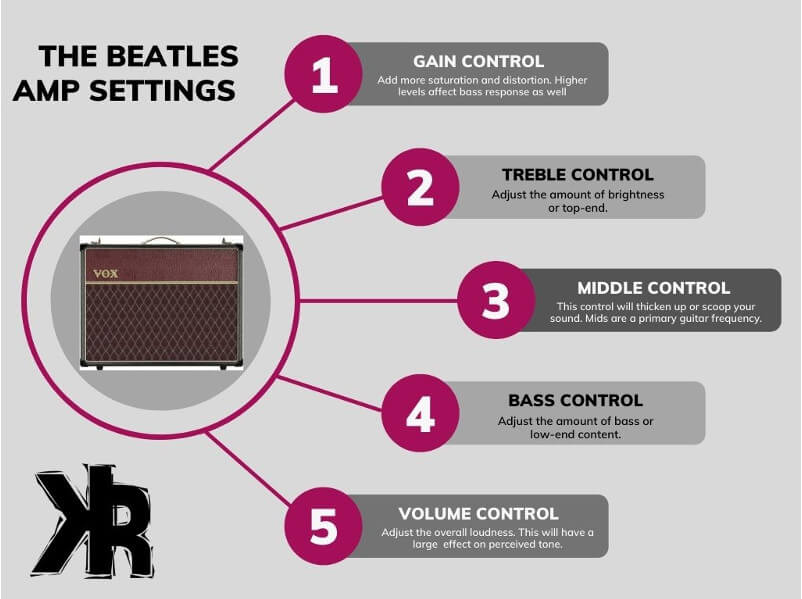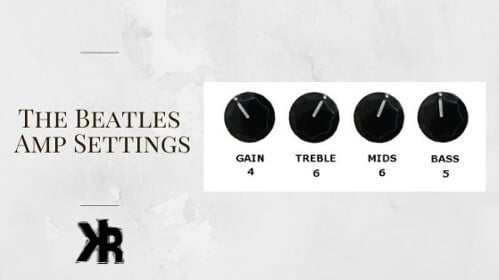Table of Contents
The Beatles are a household name and are known and loved by many. They are pioneers in many things that contribute to the different types of music we know and enjoy today. Getting their sound is quite easy with the amazing gear we have available today.
In this Killer Rig guide, we will look at the Beatles amp settings. Plus the gear needed to pull off the culture-changing tones.
What Is the Beatles’ Sound?
The Beatles’ sound is a combination of many things that made them unique and special. They were musically versatile and could play multiple genres. This included pop, rock, blues, and even classical.
Their sound is also a result of their songwriting skills. John Lennon and Paul McCartney wrote some of the most iconic songs of all time.
The Beatles used Vox amps almost exclusively with settings like:
- Gain: 5
- Treble: 6
- Mids: 8
- Bass: 5
Let’s take a look at the Beatles’ amp settings and gear that made them so special.
Not sure what amp settings actually do? Check out my guide to amp controls and settings to get up to speed!
The Beatles Amp Settings
The Beatles used Vox amps exclusively for many years to get their sound. This gave them a sound that was never heard before, and of their own making.
If you have a Vox amp, then it’s quite easy to recreate their sound, but there are a few things you will want to consider.
- You will want a guitar that has low-output pickups. Single coils would be preferred over humbuckers as they are also brighter. This is primarily the sound you want. If you have a Rickenbacker, then you’re pretty much there!
- An amp with a slight crunch tone like a Vox is preferred. You can also use a fuzz and compressor pedal to get you the rest of the way. Especially for songs that had a bit more edge.
Once you have the gear, you just need to know how to set your amp! Once you have that down, you will also have the right sound. Let’s look at what the controls do and how to use them.
Check out our guide on clean amp settings for more!

Gain Knob
This knob will control the amount of distortion in your sound. You want to have a low gain setting for the Beatles sound. On some amplifiers, it’s also called “drive” or “pre-volume”.
As a starting point, you should have the gain set at 4-5 and then experiment from there. This will depend a great deal on your guitar and the output from its pickups.
If it’s a bit too distorted for some songs, turn it down to clean it up. But you do want to aim for an edge of breakup tone, as some Beatles songs had a slight drive to their guitar sound.
Setting Your Equalizer
The Beatles used Vox AC30 amplifiers for many years. These amps had a very specific sound that was also clean and clear. To get started, it’s suggested to set your EQ controls to the halfway point.
To get the right tone, you will want to use the equalizer correctly from there.
- Your treble control is used to get the right brightness and clarity. The Beatles had a bright sound, primarily because of the guitars. To obtain the optimal brightness, experiment with the treble control. But try to prevent harshness from higher settings.
- If you have a midrange control, this too should be set fairly high. A setting around 7-8 is not uncommon for this type of sound. Too low, and you will lose some thickness, which might make your tone shrill.
- The bass control is also very important as it will add warmth and depth to your sound. This is normally fine at around the halfway point or 5. It should be tweaked to taste according to the guitar being used.
We have some great Lynyrd Skynyrd amp settings here.
Effects
Many Beatles songs also made use of effects such as reverb, echo, and delay. These are all very easy to recreate with modern pedals. You can use a digital delay pedal or even an analog one such as the MXR Carbon Copy.
For reverb, almost any spring-type pedal will do the trick. The Holy Grail is a good option, or even the Keeley Omni.
An Echo can be created with a delay pedal, but you will want to set it for a shorter time. Something around 400ms should do the trick.
The Beatles Songs And Their Settings
To get close to a lot of the songs performed by the Beatles, having some effects handy can help out. Also, keep in mind these are simply starter settings. They may need to be adjusted according to your guitar and amplifier.
Let’s take a look at a few settings to help you get close to their sound.
Twist and Shout
A very popular song that changed the way the world looked at rock music. To truly perform this song, a hollow body guitar will get you there.
When it comes to an amplifier, either a Vox AC30 or a Boss Katana modeler can get close.
Use these settings to get started:
- Gain: 4
- Treble: 6
- Mids: 7
- Bass: 5
- Reverb: 4
She Loves You
This song was an instant hit in the UK about a guy who thinks he lost his girl. To play it, again a hollow body guitar would be ideal, but a Stratocaster does it justice as well.
This song is quite clean and so if you have a Fender style amplifier, use these settings:
- Gain: 5
- Treble: 5
- Mids: 7
- Bass: 5
- Reverb: 3
Can’t Buy Me Love
The Beatles were already very popular when this upbeat song was written. It, too, became a huge success and the Beatles were well on their way to becoming the top band of the era.
To perform it, you can use a Stratocaster or Telecaster guitar just fine. As for an amplifier, almost any type will do as long as it’s fairly clean.
Start with these settings:
- Gain: 4
- Treble: 7
- Mids: 6
- Bass: 6
- Reverb: 3
Visit our page on Pink Floyd amp settings for more great sounds.
Troubleshooting Issues
If you are having issues trying to get the sound just right, there are a few things that can be done.
- Having the right guitar is important to this sound. Guitars that sound very warm with humbuckers can get close. But they are not the perfect type for the Beatles’ tone. Especially the rhythm parts.
- If you feel your tone is simply too bright and harsh, experiment with the treble control. If that still isn’t working, don’t forget to use the tone control on your guitar. Try different pickup positions as well.
- An amplifier that is low gain is a perfect choice. For any of the crunchier parts, try using a fuzz pedal. This is the best way to recreate their sound.
- Using effects is also a great way to get authentic Beatles sounds. Effects like delay and reverb can help add depth and fill out the tone.
- If you are experiencing issues with bass, try using a different pickup position. If you are trying to use the neck position, and it sounds too boomy, this could be a quick way to resolve the issue. Make sure to also decrease the bass control.
Conclusion
The Beatles were one of the most popular bands of all time. They wrote great songs and had a sound all their own. To get close to their tone, you need the right guitar and amplifier.
Use these settings as a starting point, but be sure to experiment to find what works best for you. Every setup is different and so try a few pieces of gear as well.
FAQs
What amps did The Beatles use?
The Beatles used the Vox AC series guitar amplifiers for most of their career. They began using Fender amps towards the end. They were seen with them at the last live performance they had ever played.
What type of guitars did The Beatles use?
The Beatles used mostly hollow-body guitars, like the Epiphone Casino. They also used solid-body guitars. Some of their favorites were the Fender Stratocaster, Telecaster, and Gibson Les Paul.
How much gain do I need for The Beatles’ sound?
You will want to set your amplifier until it’s at the edge of breakup. This will be plenty of gain for Beatles songs. Then, if you need anything cleaner, simply roll down your volume control on the guitar.

